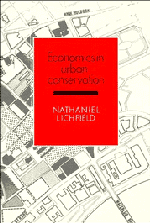Book contents
- Frontmatter
- Contents
- List of diagrams, tables and plans
- Preface
- Acknowledgements
- Introduction
- Part I Planning and management in the conservation of the urban system
- Part II Conservation of the cultural built heritage
- Part III Economics in urban conservation
- Part IV Selected tools of economic analysis for project evaluation
- 13 Financial impact: financial analysis
- 14 Economic impact: social cost benefit analysis
- 15 Community impact: community impact analysis
- Part V Case studies in the economics of conservation of the CBH
- Notes
- Bibliography
- Index
13 - Financial impact: financial analysis
Published online by Cambridge University Press: 10 November 2010
- Frontmatter
- Contents
- List of diagrams, tables and plans
- Preface
- Acknowledgements
- Introduction
- Part I Planning and management in the conservation of the urban system
- Part II Conservation of the cultural built heritage
- Part III Economics in urban conservation
- Part IV Selected tools of economic analysis for project evaluation
- 13 Financial impact: financial analysis
- 14 Economic impact: social cost benefit analysis
- 15 Community impact: community impact analysis
- Part V Case studies in the economics of conservation of the CBH
- Notes
- Bibliography
- Index
Summary
Context
In Chapter 7 we introduced a model for the approach to financial analysis for management of the built environment at any stage in the life cycle, and in Chapter 8 showed how this could be adapted for conservation of the CBH. We now demonstrate the use of the analysis for the central theme of our concern: the decision whether to rehabilitate or redevelop heritage buildings? But while answering this particular question the estimates can also illuminate others of relevance to conservation: what price to pay for a property subject to conservation via rehabilitation? What is the ceiling on capital costs of works which could be incurred with an eye to viability? What would be the limit on operating costs which could be incurred having regard to the rents to be realised?
These and related questions can be answered by the application of a generic method of financial appraisal/valuation. We do not propose to reproduce here the wide array of foundation material on this analysis, but to demonstrate the principles by reference to an imaginary example.
An illustration of financial analysis
Let us return to the 100 year old merchant house of (8.3.3) comprising 15,000 sq. ft. gross on a site of half an acre in the centre of town. It is located in the business area but has been kept in residential use until recently by the last descendant of an old family who has died.
- Type
- Chapter
- Information
- Economics in Urban Conservation , pp. 227 - 239Publisher: Cambridge University PressPrint publication year: 1989



